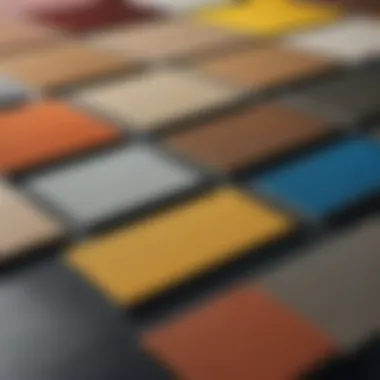Materials:
- Squared rubber flooring tiles: 100 pieces, each measuring 1x1 foot
- Adhesive glue specific for rubber materials: 2 gallons
- Sealer coat for rubber flooring: 1 gallon
- Cleaning solution suitable for rubber surfaces: 1 bottle
- Measuring tape
- Utility knife
- Paint roller
DIY Steps:
- Measure the gym floor area accurately using a measuring tape.
- Clean the ground surface thoroughly to ensure proper adhesion of the rubber tiles.
- Start from one corner and apply adhesive glue on both the back of the tile and the ground to install tiles evenly.
- Press down firmly on each tile to secure them in place.
- Trim tiles where necessary using a utility knife for a perfect fit.
- Allow the adhesive to dry completely.
- Apply a sealer coat to protect the flooring.
- Clean the floor with a suitable cleaning solution for a polished finish.
Technical Aspects:
- The installation process requires precision in measurements to ensure a seamless fit.
- Timing is crucial when applying adhesive and allowing it to dry for optimal results.
- Using a paint roller can help with even application of the sealer coat.
- Ensure proper ventilation during the sealer coat application for safety.
DIY project Process:


- Lay out the rubber tiles according to the floor plan to visualize the layout.
- Follow the step-by-step installation method for a professional finish.
- Key techniques include applying even pressure when securing the tiles and trimming accurately.
- Ensure the adhesive is allowed to set as per manufacturer's recommendations for durability.
- Troubleshooting Tips: In case of misaligned tiles, carefully adjust them before the glue sets.
- Detailed instructions, meticulous measurements, and sequential steps are crucial in achieving a flawless gym floor installation. Following these guidelines will result in a professionally finished gym floor that not only enhances the space but also provides a durable and sustainable flooring solution for your fitness area. The careful selection of materials, precise installation process, and attention to technical details will ensure that your DIY project yields exceptional results that meet high standards of quality and aesthetics.
Introduction


Installing a gym floor is a significant decision that encompasses various cost considerations ranging from material expenses to labor costs. This article delves into the intricate details of the financial aspects associated with gym floor installation, providing a comprehensive guide for individuals looking to enhance their workout space. Gym floors play a crucial role in creating a safe and conducive environment for fitness enthusiasts, whether in a residential or commercial setting. Understanding the key factors influencing the costs involved in setting up a gym floor is essential for effective budget planning and decision-making.
To start, exploring the different types of gym flooring materials and their cost comparisons can help in selecting the most suitable option based on budget and requirements. The size and layout of the gym space also play a vital role in determining installation costs, with square footage and layout complexity impacting the overall expenses. Additionally, the method of installation, whether opting for professional services or considering a DIY approach, can significantly affect the budget allocation for the project. Subfloor condition, location, accessibility, and the incorporation of special features or customizations further add layers of complexity to the cost analysis for gym floor installation.
Considering the comprehensive nature of gym floor installation costs, this article aims to provide a detailed breakdown of each element involved in the process. By dissecting material costs, labor expenses, hidden costs, and maintenance considerations, readers can gain valuable insights into effectively budgeting for and managing the financial aspects of installing a gym floor. Through an in-depth exploration of these factors, individuals can make informed decisions that align with their specific needs, preferences, and financial capabilities.
Factors Influencing Gym Floor Installation Costs


In the realm of gym floor installation, numerous factors come into play that significantly influence the total costs involved. Understanding these factors is crucial for anyone embarking on the journey of setting up a gym space. By delving into the specifics of each element, one can make informed decisions that align with their budget and requirements.
Gym Floor Material
When it comes to gym floor materials, the options are diverse and tailored to meet various needs and preferences. Different types of gym flooring materials, such as rubber, foam, or vinyl, offer distinct characteristics and benefits. For instance, rubber flooring provides excellent durability and shock absorption, making it a popular choice for high-traffic areas or intense workout spaces. On the other hand, foam flooring excels in providing cushioning and comfort, perfect for areas where impact absorption is crucial.
In terms of cost comparison, evaluating the upfront and long-term expenses of different materials is essential. While some materials may have a higher initial cost, they could prove more cost-effective in the long run due to their durability and maintenance requirements. Understanding the cost implications of each material type helps in selecting the most suitable option based on budget and usage needs.
Gym Size and Layout
The size and layout of a gym space play a pivotal role in determining installation costs. The square footage directly impacts the amount of material needed, affecting the overall expenses. Larger gyms require more flooring material, leading to higher costs, whereas smaller spaces may offer cost savings in material purchase and installation.
Moreover, the complexity of the layout influences installation intricacies and labor requirements. A gym with multiple rooms, corners, or irregular shapes poses challenges during installation, potentially increasing labor costs. Simplified layouts, on the other hand, facilitate a smoother installation process and may reduce overall expenses.
Installation Method
Choosing between professional installation services and DIY approaches is a critical decision that affects the total cost of installing a gym floor. Professional installations ensure precision and quality but come at a higher cost due to labor charges. On the contrary, opting for a DIY installation can save on labor expenses but demands time, effort, and expertise from the individual undertaking the task.
Considering the pros and cons of each method is essential. Professional installations offer expertise and efficiency, ensuring a flawless finish but may be costlier. DIY installations provide flexibility and cost savings but require adequate skills and effort from the person handling the project.
Subfloor Condition
The condition of the subfloor beneath the gym flooring significantly impacts installation costs. An uneven or damaged subfloor requires additional preparation and repairs, adding to the overall expenses. Addressing subfloor issues upfront is crucial to ensure a stable foundation for the gym floor installation.
Moreover, the quality of the subfloor directly affects the longevity and performance of the gym flooring. Investing in subfloor repairs and preparation enhances the durability of the flooring material and prevents future issues, ultimately reducing maintenance costs in the long term.
Location and Accessibility
Factors such as the location of the gym space and its accessibility influence installation costs. Urban areas or remote locations may have varying labor rates and material transport expenses, affecting the overall budget. Furthermore, inadequate accessibility to the site can pose challenges in delivering and installing the flooring material.
Considering the location-related costs and accessibility issues beforehand helps in planning the budget effectively. Factoring in these variables ensures a smoother installation process and prevents unexpected financial surprises during the project.
Additional Features
Incorporating specialized features and customization options into the gym floor design adds a layer of uniqueness and functionality to the space. Specialized features like shock absorption layers or anti-slip coatings enhance safety and performance, albeit at an additional cost. Customization options such as branding or color choices cater to individual preferences but might come with extra expenses.
Understanding the benefits and drawbacks of additional features is essential in making informed decisions during the installation process. Balancing the desire for customization with budget constraints ensures a tailored gym floor that meets both aesthetic and practical requirements.
Calculating Gym Floor Installation Costs
In this extensive analysis of the cost implications of installing a gym floor, the section on calculating gym floor installation costs holds paramount importance. As individuals or business owners embark on the journey of enhancing their fitness spaces, understanding the financial aspects is crucial. The calculation of installation costs delves into various components such as material expenses, labor outlay, and additional costs that collectively shape the overall budget needed for this project. By meticulously dissecting these cost elements, stakeholders can gain a comprehensive overview of the financial commitments involved in establishing a gym floor.
Cost Breakdown of Different Gym Flooring Materials
When it comes to gym flooring materials, the cost breakdown plays a pivotal role in determining the overall expense of the installation project. Different types of materials carry varying price tags, influenced by factors such as durability, quality, and maintenance requirements. Analyzing the cost breakdown of different gym flooring materials provides insight into the most cost-effective options without compromising on performance. This detailed examination allows individuals to make informed choices based on their budget constraints and long-term investment goals. Understanding the nuances of material costs empowers decision-makers to select the most suitable flooring option that aligns with their financial plans.
Professional Installation Costs
Professional installation costs are a significant aspect of calculating gym floor installation expenses. Hiring skilled professionals ensures the proper fitting and installation of the gym floor, guaranteeing a seamless and durable final outcome. While professional services come at a higher price point compared to DIY alternatives, the expertise and precision offered by experienced installers justify the investment. By exploring professional installation costs in detail, individuals can appreciate the value of entrusting their flooring project to qualified professionals, thereby minimizing the risk of errors or subpar workmanship during installation.
DIY Labor Considerations
On the flip side, DIY labor considerations present a more hands-on and budget-friendly approach to installing a gym floor. Undertaking the installation process independently allows individuals to potentially save on labor expenses and exercise greater control over the project timeline. However, DIY endeavors also come with their set of challenges, including the need for specialized tools, technical know-how, and time commitment. Evaluating the benefits and drawbacks of DIY labor considerations equips individuals with the awareness needed to make an informed decision based on their skills, available resources, and project requirements.
Hidden Costs to Consider
In addition to material and labor expenses, factoring in hidden costs is paramount when calculating gym floor installation outlays. These hidden costs may include unforeseen expenses related to site preparation, permits, or unforeseen structural challenges that emerge during the installation process. By proactively identifying and budgeting for hidden costs, individuals can mitigate financial surprises and ensure the smooth progression of the installation project. Understanding the significance of hidden costs and their potential impact on the overall budget aids in establishing a more accurate financial plan for executing the gym floor installation.
Maintenance and Repair Expenses
Lastly, maintenance and repair expenses constitute a critical component of the total cost of owning a gym floor. Beyond the initial installation outlay, ongoing maintenance, repairs, and replacements of flooring components contribute to the long-term expenditure associated with gym flooring. Evaluating the maintenance and repair expenses upfront enables individuals to anticipate the lifecycle costs of different flooring materials and plan accordingly to preserve the longevity and aesthetics of their gym floor. By grasping the implications of maintenance and repair expenses, stakeholders can make informed decisions regarding the selection and care of gym flooring materials to optimize durability and minimize future financial burdens.
Budgeting Tips for Gym Floor Installation
In the realm of gym floor installation, understanding budgeting tips holds significant importance. Proper budget allocation can make or break the success of your project, ensuring that you stay within financial constraints while achieving desirable outcomes. When delving into the world of gym floor installation costs, having a clear budgeting strategy is essential for prudent financial management. Not only does it prevent overspending, but it also allows for a structured approach towards allocating resources efficiently.
Setting a realistic budget is not merely about determining a random figure but involves a thorough analysis of various cost elements associated with gym floor installation. This includes but is not limited to material expenses, labor fees, additional costs, and potential hidden expenditures. By emphasizing the significance of budgeting tips in this article, we aim to equip readers with the knowledge and insight necessary to approach gym floor installation with financial prudence and foresight.
Setting a Realistic Budget
Researching Cost Estimates
Researching cost estimates plays a pivotal role in the budgeting process for gym floor installation. It involves gathering information on the average costs of materials, labor, and other related expenses from multiple sources. By exploring various cost estimates, individuals can gain a comprehensive understanding of the financial implications of their project. This allows for informed decision-making and realistic budget setting based on accurate data rather than mere speculation.
One key characteristic of researching cost estimates is its ability to provide a benchmark for evaluating the reasonableness of proposed budgets. It serves as a comparative tool, enabling individuals to assess whether their financial allocations align with industry standards and prevailing market rates. This analytical approach helps in identifying potential cost-saving opportunities and optimizing budget distribution for optimal outcomes.
Allocating Funds Wisely
The art of allocating funds wisely is a crucial aspect of budgeting for gym floor installation. It involves judiciously distributing financial resources across various expense categories to maximize cost-efficiency without compromising quality. By channeling funds strategically towards essential aspects such as high-quality materials, experienced labor, and necessary features, individuals can enhance the overall value of their investment.
A key characteristic of allocating funds wisely is its focus on optimizing resource utilization to achieve desired results within budget constraints. This approach emphasizes prioritizing critical expenses while minimizing unnecessary spending, ensuring that every dollar contributes meaningfully to the project's success. By carefully allocating funds based on project priorities and goals, individuals can streamline their budgeting process and foster a more efficient use of financial resources.
By embracing prudent budgeting tips such as researching cost estimates and allocating funds wisely, individuals can navigate the complexities of gym floor installation costs with confidence and clarity. These practices empower individuals to approach their projects with financial acumen and foresight, ultimately leading to cost-effective solutions and superior outcomes.
Conclusion
In any construction project, including the installation of a gym floor, the conclusion plays a vital role in tying together all the intricate details and considerations discussed throughout the analysis. The conclusion section of this article serves as a pivotal point where readers can reflect on the plethora of factors that impact the cost of gym floor installation. By summarizing key takeaways and insights from the article, the conclusion provides a clear understanding of the financial commitments and planning necessary. It outlines the significance of meticulous budgeting, realistic expectations, and the foresight required in ensuring a successful gym floor installation process.
Moreover, the conclusion reaffirms the importance of adequate research and informed decision-making when it comes to determining the budget, selecting appropriate materials, assessing labor costs, and factoring in hidden expenses for maintenance and repairs. It emphasizes that setting a realistic budget based on thorough cost estimates is essential to avoid financial pitfalls and ensure the longevity and performance of the gym floor.
Furthermore, the conclusion underlines the satisfaction and pride that come with enjoying the final result of a diligently planned and well-executed gym floor installation. It highlights how attention to detail, adherence to the budget, and prudent decision-making culminate in a functional and aesthetically pleasing gym floor that enhances the overall ambiance of the space. Ultimately, the conclusion acts as a compass, guiding readers from the initial planning stages to the ultimate fruition of their gym floor installation project, instilling confidence and empowerment in making informed financial choices for this significant investment.





